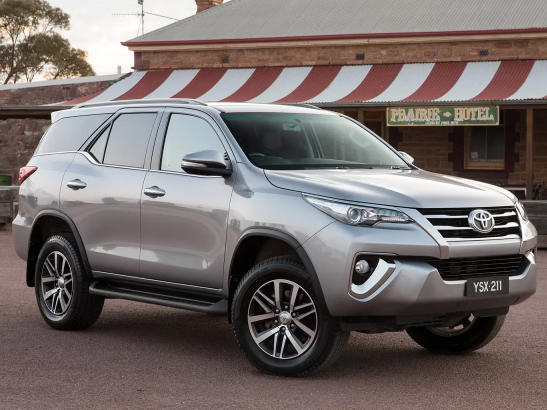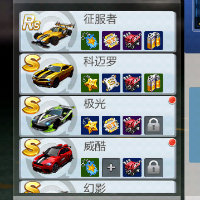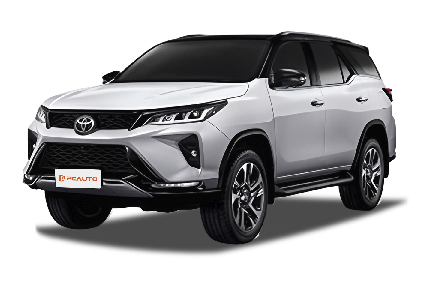Q
What are the common problems with Fortuners?
The Toyota Fortuner, a popular SUV in the Malaysian market, has its common issues mainly centered around the stiff suspension setup, which compromises long-distance comfort—rear passengers especially may feel the bumps on rough roads, a trade-off for its off-road-focused tuning. Some owners report that the 2.7L petrol engine delivers rather flat torque at low revs, making it better suited for city driving; if you frequently carry heavy loads or tackle hills, the 3.0L diesel variant is a smarter pick. Inside, the plastic dashboard trim can sometimes creak in hot weather, but regular treatment with rubber protectant helps reduce the noise. Electronic components like the reverse camera might temporarily fail due to moisture during the rainy season, so keeping the connectors sealed should prevent that. It’s worth noting the Fortuner’s high ground clearance takes some getting used to for new drivers when getting in and out, but it also gives it an impressive 700mm water-wading capability—perfect for Malaysia’s rainy climate. Regularly replacing the original shock absorbers and transmission fluid (every 40,000 km is recommended) can significantly extend the chassis lifespan, and with Toyota’s 5-year warranty covering most mechanical parts, sticking strictly to the maintenance manual is the best way to keep it running in top shape.
Special Disclaimer: This content is published by users and does not represent the views or position of PCauto.
Related Q&A
Q
Is the Toyota Fortuner bumpy?
When it comes to whether the Toyota Fortuner rides rough, the SUV's comfort level mainly depends on its suspension setup and the road conditions. The Fortuner features a body-on-frame construction and a rear solid axle suspension design – this setup provides better rigidity for off-roading, but it can transmit more road vibrations when driving on regular paved roads, especially noticeable for rear passengers. However, Toyota engineers have optimized it for city driving, so it's already more comfortable than a pure off-road vehicle. If you find the suspension too stiff, you can check if the tire pressure is too high or consider switching to tires better suited for highway driving. Malaysian consumers should note that there are slight differences in suspension tuning across different model years of the Fortuner; post-2016 facelift models saw improvements in comfort. Additionally, the vehicle's load capacity also affects suspension performance. It's recommended to test drive the vehicle yourself before purchasing and compare it with other SUVs in its class. After all, each model has unique suspension characteristics, and the key is to choose the one that best fits your daily usage needs.
Q
What is the difference between Fortuner and legender?
The Toyota Fortuner and Legender are two SUVs with distinct positioning, differing mainly in design and features. The Legender can be seen as the premium, upgraded version of the Fortuner. As Toyota's main seven-seater SUV in Southeast Asia, the Fortuner focuses on practicality and off-road capability, featuring a body-on-frame construction and part-time 4WD system—ideal for family trips or light off-roading. Meanwhile, the Legender, built on the Fortuner platform, boasts a sleeker, sportier look with a blacked-out grille, LED headlights, and exclusive wheel designs. Its interior uses higher-quality materials and adds tech touches like a full digital instrument cluster, targeting a urban luxury vibe. Notably, it only offers a five-seat layout to enhance rear passenger comfort and space. Both share the 2.8L turbo diesel engine, but the Legender’s tuning prioritizes a smoother driving experience. For Malaysian buyers, the Fortuner makes sense if you value affordability and versatility, while the Legender better suits those craving personality and premium features. It’s worth mentioning that this "twin-model" strategy is common for Toyota in Southeast Asia—similar to the Hilux and Hilux Rogue—using differentiated designs to cater to diverse customer groups while sharing platforms to cut production costs.
Q
What are common problems with the 2021 Fortuner?
The 2021 Toyota Fortuner has generally proven reliable in the Malaysian market, though some owners have reported a few common issues. For instance, diesel engine variants might experience brief shaking during cold starts, which is usually linked to the local humid climate or fuel quality. It's advisable to regularly replace the fuel filter and use the recommended diesel grade. Some owners have also mentioned that the third-row seating feels a bit cramped, with average comfort for long journeys—this is a typical design trade-off seen in most seven-seat SUVs. Additionally, there are a small number of cases where the infotainment system occasionally freezes, which can be fixed with a software update. Notably, while the Fortuner's body-on-frame construction ensures off-road durability, the suspension tuning feels on the stiffer side when driving on paved roads, a characteristic trait of rugged SUVs. Malaysian owners are advised to pay special attention to regular checks of the chassis rubber components, as the local rainy climate may accelerate wear on these parts. Overall, these issues fall within the normal range for vehicles in this class, and adhering to scheduled official maintenance can effectively prevent them. For consumers considering a used model, it’s recommended to focus on inspecting the 4WD system’s functionality and chassis rust conditions—areas that require extra attention in Malaysia’s humid environment.
Q
Does the 2021 Fortuner have Apple CarPlay?
The 2021 Toyota Fortuner does come with Apple CarPlay in the Malaysian market. This feature lets drivers seamlessly connect their iPhones to the infotainment system, giving them access to navigation, music, calls, and other apps—definitely a boost for both convenience and in-car entertainment. As a popular SUV among Malaysian buyers, the Fortuner's tech features have always kept up with market demands. Besides Apple CarPlay, some variants might also support Android Auto to cater to different smartphone users. It's worth noting that specific features can vary depending on the trim level or regional specifications, so it's a good idea to check the exact specs with dealers before buying. Plus, with the rapid growth of in-car connectivity, more and more models are adding smart features like voice control and wireless connectivity. These tech upgrades not only make driving safer and easier but also show how the auto industry is moving toward digitalization and smart technology. For Malaysian consumers, picking a car with an advanced infotainment system isn't just about meeting daily needs—it also ensures the vehicle stays practical for years to come.
Q
Why did Toyota stop making the Fortuner?
Toyota's decision to stop producing the Fortuner mainly stems from market strategy and product line optimization. As consumer demands evolve and environmental regulations become increasingly stringent, Toyota is shifting resources toward models that better align with current market trends, such as hybrid and fully electric SUVs, to meet the global demand for energy-efficient and eco-friendly vehicles, including in markets like Malaysia. While the Fortuner, as a traditional fuel-powered SUV, was once highly popular in Southeast Asia, intensifying market competition and shifting consumer preferences have likely led Toyota to focus on more forward-looking products. Additionally, Toyota's newer SUV models like the RAV4 and Highlander, with their more advanced technology and features, have gradually taken over the Fortuner's market position. For Malaysian consumers, while the discontinuation of the Fortuner may be disappointing, Toyota still offers other excellent SUV options, such as the durable and reliable Hilux and the premium and comfortable Land Cruiser, which are well-suited to Malaysia's road conditions and driving needs. Looking ahead, Toyota will likely continue to launch more models tailored to the local market to cater to consumers' diverse demands.
Q
What is the Fortuner facelift 2021?
The 2021 Toyota Fortuner facelift is Toyota's updated mid-size SUV for the Southeast Asian market, with tweaks focused on exterior styling, interior upgrades, and tech features. On the outside, it gets sharper LED headlamps, a brand new designed front grille, and sportier front and rear bumpers. Inside, there's improved soft-touch materials and nicer trim, plus a touchscreen that supports Apple CarPlay and Android Auto. Under the hood, it carries over the 2.7-liter petrol and 2.8-liter turbo diesel engine options, mated to a 6-speed automatic transmission, with 4WD available on some variants. This SUV is pretty popular in Malaysia – its durability and off-road capability make it a good fit for the country's diverse road conditions. As a key Toyota model in Southeast Asia, every Fortuner update includes tweaks tailored to tropical climates and local roads, like better aircon performance and a tougher chassis. For Malaysian buyers eyeing a 7-seater SUV, it's a practical pick that balances family use and outdoor adventures. Rivals in its class include the Mitsubishi Pajero Sport and Isuzu MU-X, but the Fortuner holds strong market appeal thanks to Toyota's brand reputation and well-established after-sales network.
Q
What is the update for Fortuner 2021?
Toyota launched the facelifted Fortuner in the Malaysian market in 2021, focusing on upgrades to its exterior, interior, and features. On the outside, it gets a newly designed grille, LED headlamps and taillights, plus fresh wheel designs, giving the overall look a more stylish and dynamic vibe. Inside, the center console has been revamped, fitted with a larger touchscreen and an updated infotainment system that supports Apple CarPlay and Android Auto, boosting both tech appeal and practicality. In terms of safety, the Toyota Safety Sense suite comes standard across the range, including pre-collision system, lane departure alert, adaptive cruise control, and more, further enhancing driving safety. Under the hood, it continues with the 2.7-liter petrol and 2.8-liter turbo diesel engines, mated to a 6-speed automatic gearbox, with 4WD available on some variants to meet different customer needs. For Malaysian buyers, the Fortuner has long been known for its reliability, durability, and off-road capability, making it a great fit for the country's varied road conditions and family use. The facelifted model builds on those strengths with exterior and feature upgrades, keeping it competitive and still a solid pick in the midsize SUV segment.
Q
What is the warranty on a Toyota 2021?
According to Toyota Malaysia's official policy, the 2021 Toyota models come with a 5-year unlimited mileage factory warranty. This covers major mechanical components such as the engine, transmission, and drive system. New cars also include complimentary maintenance services, with the specific number of visits depending on the model, typically ranging from 3 to 5 regular services. It's important to note that warranty terms require owners to carry out regular maintenance at authorized service centers as per official regulations; otherwise, warranty benefits may be affected. For hybrid models, the high-voltage battery pack usually comes with an additional warranty of 8 years or a specific mileage, whichever comes first. Malaysia's hot and rainy climate can cause significant wear and tear on vehicles. In addition to keeping an eye on the warranty period, owners are advised to pay special attention to regular checks of climate-vulnerable components like the air conditioning system, rubber seals, and chassis rust protection. Toyota has an extensive after-sales service network in Malaysia, and owners can conveniently book maintenance and check warranty status through the MyToyoTA app.
Q
How many kilometers can a Fortuner run in a full tank?
The Toyota Fortuner's full-tank range depends on the specific model and driving conditions. Generally, the 2.7-liter gasoline engine version has an 80-liter fuel tank and averages around 10-12 liters per 100 kilometers in mixed driving, so you're looking at roughly 650-800 kilometers on a full tank. The 2.8-liter diesel engine model has the same tank size but is more fuel-efficient, sipping about 7-9 liters per 100 kilometers, pushing the range up to 900-1100 kilometers. Your actual mileage will vary based on driving habits, road conditions, and payload—highway cruising keeps fuel consumption lower, while stop-and-go city traffic will eat into that range. We recommend regular vehicle maintenance: keeping tires properly inflated, cleaning out carbon deposits, those little things really help optimize fuel efficiency. Also, in Malaysia's hot weather, running the AC for extended periods can crank up fuel use, so using the air conditioning system wisely can also have a positive impact on how far you can go.
Q
What is the tank capacity of Fortuner 2021?
The 2021 Toyota Fortuner comes with an 80-liter fuel tank, a design that meets the demands of long-distance driving by reducing refueling stops and boosting on-road convenience. As a popular SUV in the Malaysian market, the Fortuner's fuel tank capacity is well-matched to its powertrains – both the 2.7-liter petrol and 2.8-liter diesel engine variants feature this tank size, ensuring consistent range performance across different road conditions. For owners who frequently take inter-state trips or go on outdoor adventures, an 80-liter tank is a practical choice, especially in Malaysia's more remote areas where gas stations might not be as densely packed as in cities – a larger tank offers extra peace of mind. Plus, the tank capacity was designed with the vehicle's overall weight distribution and space utilization in mind, ensuring driving stability and passenger comfort. Knowing the tank capacity helps owners better plan their journeys and budget for fuel costs, which is especially important when fuel prices are fluctuating.
Popular Cars
Model Year
Car Compare
Car Photo
Latest Q&A
Q
How much did a new 2018 beetle cost?
The 2018 Volkswagen Beetle had a starting price range of approximately RM120,000 to RM180,000, depending on the trim and options. The entry-level 1.2 TSI Design model was the most affordable, while the top-spec 2.0 TSI R-Line version approached RM180,000—though final pricing could vary with optional extras and dealer promotions.
As a timeless classic, the 2018 Beetle kept its retro charm but packed modern tech like a touchscreen infotainment system and active safety features. Under the hood, buyers could choose between the fuel-efficient 1.2T or the more spirited 2.0T engine.
Fair warning: Volkswagen discontinued the Beetle in 2019, so you’ll only find it on the used market now. That said, its iconic design and nostalgic appeal still make it a hit among collectors. If you’re eyeing a pre-owned model, always check the vehicle history and maintenance records to snag a solid deal.
Q
What engine does a 2018 VW Beetle have?
The 2018 Volkswagen Beetle offered two gasoline engine options across different markets. The primary powerplant was a 1.2-liter TSI turbocharged inline-four, delivering 105 horsepower and 175 Nm of torque, paired with a 7-speed DSG dual-clutch transmission. This compact forced-induction engine struck a balance between urban fuel efficiency and strong low-end torque.
Higher-spec variants featured an optional 1.4-liter TSI turbocharged unit, bumping output to 150 horsepower. Both engines adopted direct fuel injection and belonged to VW’s widely used EA211 modular family, featuring modern tech like lightweight aluminum blocks.
Though retaining its iconic silhouette, this generation Beetle actually shared its underpinnings with the Golf, inheriting the brand’s proven front-wheel-drive architecture. This platform commonality also translated to easier maintenance, as local dealerships were well-versed in servicing these powertrains thanks to extensive parts sharing across VW’s lineup.
Q
What are the different models of the 2018 VW Beetle?
The 2018 Volkswagen Beetle comes in three main trims: Classic, Trendline, and Sport. All models are powered by a 1.2-liter TSI turbocharged engine delivering 105 horsepower, paired with a 7-speed DSG dual-clutch transmission—perfect for city driving with its nimble handling and solid fuel efficiency.
The entry-level Classic trim rolls on 16-inch wheels and features a basic multimedia system. Stepping up to the Trendline adds 17-inch wheels, fog lights, and chrome accents. The Sport trim leans into its name with 18-inch wheels, a sport-tuned suspension, and unique interior color options.
This generation keeps the Beetle’s iconic retro curves but modernizes them with touches like LED daytime running lights. Inside, you’ll find color-matched dash panels, and with 310 liters of trunk space, it’s more practical than most small cars in its class.
Since the Beetline was discontinued in 2019, the 2018 model stands as the last new generation, making it a rising collector’s item—especially the convertible, which holds strong appeal in the used market. For maintenance, stick to routine service every 15,000 km or 12 months, and regular 95-octane fuel is all it needs.
Q
Does the 2018 Beetle have Apple CarPlay?
The 2018 Volkswagen Beetle did come equipped with Apple CarPlay, integrated into its Composition Media infotainment system. This allowed iPhone users to seamlessly connect for navigation, music, and other apps. The system also supported Android Auto, catering to different smartphone users with its intuitive and responsive interface—definitely a plus for convenience on the road.
That said, some early-production 2018 models might require a software update to activate the feature, so it’s worth checking with an official dealer to confirm your car’s specs or available upgrades. Also, wireless Apple CarPlay wasn’t standard across all trims; it depended on the factory-installed options.
For fans of classic styling who still want modern tech, the Beetle struck a nice balance between retro charm and everyday usability. Competitors like the Mini Cooper offered similar connectivity, but let’s be honest—the Beetle’s iconic design was always its standout feature.
Q
What is the fuel economy of the 2018 Beetle?
The 2018 Volkswagen Beetle's fuel efficiency varies by powertrain. The 1.2L TSI turbocharged version delivers a combined fuel consumption of around 5.5L/100km, while the 1.4L TSI model is slightly thirstier at approximately 6.0L/100km – both perform best with 95-octane petrol.
You'll likely see higher consumption in city driving, but it cruises efficiently on highways thanks to its classic aerodynamic design. For better mileage, stick to routine maintenance like cleaning the air filter and keeping tyres properly inflated. These small habits can help squeeze out extra kilometres per litre.
Though discontinued, the 2018 Beetle remains popular in the used car market – its iconic styling and decent fuel economy make it a practical daily driver. Just remember real-world figures depend heavily on driving style and road conditions, so check owner forums for real-life feedback.
View MoreRelated News

Toyota Fortuner: Spacious 7-Seater Layout, the Ideal Choice for Family Travel
AshleyMay 4, 2025

2026 Toyota HiLux receives five-star ANCAP safety rating in ANCAP
MichaelDec 12, 2025

2026 Toyota bZ4X features a larger battery and longer range but needs to be sold at a lower price
WilliamDec 12, 2025

Toyota introduces Wolfspeed SiC power semiconductors, considering their durability to be better
JohnDec 11, 2025

Toyota IMV Origin is an unfinished vehicle, born for those who need it most around the world.
JamesDec 9, 2025
View More

















Pros
Cons